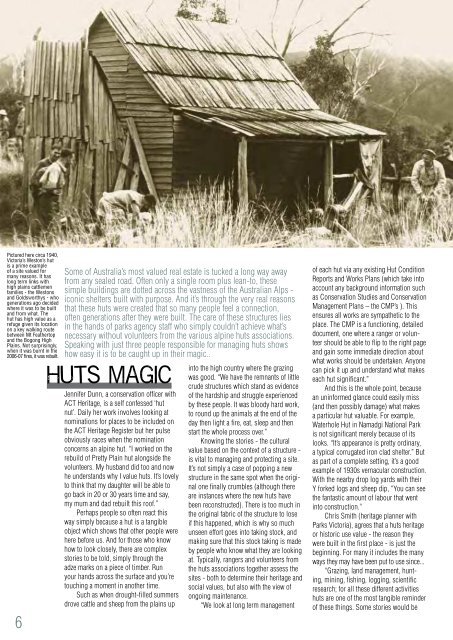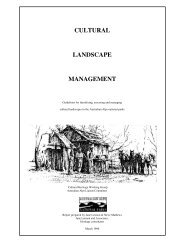Download Newsletter number 42 ( PDF - 1.25 MB) - Australian Alps ...
Download Newsletter number 42 ( PDF - 1.25 MB) - Australian Alps ...
Download Newsletter number 42 ( PDF - 1.25 MB) - Australian Alps ...
- No tags were found...
Create successful ePaper yourself
Turn your PDF publications into a flip-book with our unique Google optimized e-Paper software.
L: Noy Garner dressinga slab with a broad axe.R: Regina Roach andteam splitting and trimmingshingleskeeping bush skills aliveGiven each hut is a unique pastiche of building materials and methods, the army of volunteers and agency staff who care for themneeds to have an extraordinarily varied skill set. Luckily, through specially run workshops, the expertise held by an existing group ofbush craftspeople - people who were taught by their fathers and grandfathers - is being passed on to a keen and ever widening group ofvolunteers. Taking part is just one way to connect with huts, literally through the tools and fabric that have made them.The latest workshop was recently held at Currango Homestead in the Snowy Mountains where 40 people learned how to handle theadze, broad axe, maul & froe. And who were these people? Agency staff from NSW Parks, Parks Victoria, architects specialists and rangersfrom ACT Heritage department, volunteers from both the Kosciuszko Huts Association and the Victorian Huts Association, as well asothers simply interested in conserving the huts they’ve visited. Keep an eye out for news of the next workshop in the ACT.Pictured here circa 1940,Victoria’s Weston’s hutis a prime exampleof a site valued formany reasons. It haslong term links withhigh plains cattlemenfamilies - the Westonsand Goldsworthys - whogenerations ago decidedwhere it was to be builtand from what. Thehut has high value as arefuge given its locationon a key walking routebetween Mt Feathertopand the Bogong HighPlains. Not surprisingly,when it was burnt in the2006-07 fires, it was rebuilt.6Some of Australia’s most valued real estate is tucked a long way awayfrom any sealed road. Often only a single room plus lean-to, thesesimple buildings are dotted across the vastness of the <strong>Australian</strong> <strong>Alps</strong> -iconic shelters built with purpose. And it’s through the very real reasonsthat these huts were created that so many people feel a connection,often generations after they were built. The care of these structures liesin the hands of parks agency staff who simply couldn’t achieve what’snecessary without volunteers from the various alpine huts associations.Speaking with just three people responsible for managing huts showshow easy it is to be caught up in their magic..huts magicJennifer Dunn, a conservation officer withACT Heritage, is a self confessed ‘hutnut’. Daily her work involves looking atnominations for places to be included onthe ACT Heritage Register but her pulseobviously races when the nominationconcerns an alpine hut. “I worked on therebuild of Pretty Plain hut alongside thevolunteers. My husband did too and nowhe understands why I value huts. It’s lovelyto think that my daughter will be able togo back in 20 or 30 years time and say,my mum and dad rebuilt this roof.”Perhaps people so often react thisway simply because a hut is a tangibleobject which shows that other people werehere before us. And for those who knowhow to look closely, there are complexstories to be told, simply through theadze marks on a piece of timber. Runyour hands across the surface and you’retouching a moment in another time.Such as when drought-filled summersdrove cattle and sheep from the plains upinto the high country where the grazingwas good. “We have the remnants of littlecrude structures which stand as evidenceof the hardship and struggle experiencedby these people. It was bloody hard work,to round up the animals at the end of theday then light a fire, eat, sleep and thenstart the whole process over.”Knowing the stories - the culturalvalue based on the context of a structure -is vital to managing and protecting a site.It’s not simply a case of popping a newstructure in the same spot when the originalone finally crumbles (although thereare instances where the new huts havebeen reconstructed). There is too much inthe original fabric of the structure to loseif this happened, which is why so muchunseen effort goes into taking stock, andmaking sure that this stock taking is madeby people who know what they are lookingat. Typically, rangers and volunteers fromthe huts associations together assess thesites - both to determine their heritage andsocial values, but also with the view ofongoing maintenance.“We look at long term managementof each hut via any existing Hut ConditionReports and Works Plans (which take intoaccount any background information suchas Conservation Studies and ConservationManagement Plans – the CMP’s ). Thisensures all works are sympathetic to theplace. The CMP is a functioning, detaileddocument, one where a ranger or volunteershould be able to flip to the right pageand gain some immediate direction aboutwhat works should be undertaken. Anyonecan pick it up and understand what makeseach hut significant.”And this is the whole point, becausean uninformed glance could easily miss(and then possibly damage) what makesa particular hut valuable. For example,Waterhole Hut in Namadgi National Parkis not significant merely because of itslooks. “It’s appearance is pretty ordinary,a typical corrugated iron clad shelter.” Butas part of a complete setting, it’s a goodexample of 1930s vernacular construction.With the nearby drop log yards with theirY forked logs and sheep dip, “You can seethe fantastic amount of labour that wentinto construction.”Chris Smith (heritage planner withParks Victoria), agrees that a huts heritageor historic use value - the reason theywere built in the first place - is just thebeginning. For many it includes the manyways they may have been put to use since...“Grazing, land management, hunting,mining, fishing, logging, scientificresearch; for all these different activitieshuts are one of the most tangible reminderof these things. Some stories would beOriginally built in 1939by Tom Oldfield, hisson Jack and HarryTyrie, conservationworks were carriedout at Waterhole hutNamadgi National Park(ACT) in 2003-04.In December 2010,ranger Dave Whitfieldon a routine inspectiondiscovered the hutunder a fallen tree - thelikely cause being therecent high rainfall.Once the tree wasremoved, much toeveryone’s relief noneof the con-servationwork had been affectedapart from a few ‘dings’in the iron roof.difficult to tell without something in thelandscape to help tell it. If you come acrossa logging hut it’s a great opportunity to makea connection with the people who built thehut, lived here, worked in the <strong>Alps</strong>. It’s a wayto understand their land use activities.”Whatever their origin, in current timeshuts can also play a refuge role. “Thoughvisitors are encouraged to go preparedto camp out, if circumstances demandit, huts do offer shelter. Some - such asCleeve Cole Memorial Hut - exist simplybecause there was no shelter when it wasneeded.” (This particular hut was builtin 1937 in memory of skier Cleve Colewho was caught up in bad weather anddied of exposure despite the efforts of hiscompanions.)Huts are clearly appreciated for theiraesthetic value. “People appreciate theirrustic character, the smoky interiors, thetimbers and furniture polished throughyears of use. Huts appear picturesquein the landscape. Of the thousands ofhectares in Victoria’s Alpine National Park,where do people go? To huts. They are afocus of activity, a destination. Surely thisis a measure of their value.”Chris also points out a continuity thatmay not be obvious at first glance, thathuts are usually well positioned, and notby chance. Very often the people who tookcattle into the <strong>Alps</strong> followed the existingpathways of the First Peoples. They’dbuild their huts where there was naturalshelter and water, often at a place wherethese pathways crossed - places wherepeople had always camped.According to Jennifer Dunn, MeganBowden, a ranger with the NSW Parks andWildlife Service is also a ‘hut nut’. Partof Megan’s role involves the logistic coordinationfor huts maintenance throughto reconstruction of huts burnt in 2003-a challenge ramped up by the location ofmany of the sites in Kosciuszko NationalPark.Megan explains that rangers areultimately responsible for the huts in theirpatch, and are guided by a managementplan for each. This to do list and significanceassessment has been put togetherby a heritage consultant in consultation withthe ranger and with each hut’s volunteercaretaker group. While the items on thelist may be familiar to most home owners- roofing, drainage, stumping - for huts, aslightly different approach is necessary.“The aim is to carry work out in a balancedway - to do as much as is necessarybut as little as possible - to retain as muchof the original fabric but keeping in mindthat you don’t want the hut to fall down.”For example, if a hut’s original stumpsare timber, replacing them with obscuredconcrete equivalents may extend the hutsability to weather longer before the nextmaintenance intervention is needed.There are 70 huts in Kosciuszko NationalPark, over 200 still standing acrossthe <strong>Alps</strong>, and as Megan points out, “...each one is different; not one is the same.”This is because they display differentmaterials in a range of ingenious oftenout-of-necessity combinations. Log, corrugatediron, split slab, river stone, pisé orrammed earth - there are endless combinations.“There are no hardware stores inthe <strong>Alps</strong> so the people who’ve built thesestructures have been masters of makingdo: using fencing wire instead of nails;cannibalizing old huts to recycle them intonew structures. We also see changes intechnologies - where bark and shinglesroofed early huts, have been replaced withcorrugated iron, sometimes simply bylaying the iron sheets over the top.”No wonder huts offer visitors such arich means of interpreting European culturein this setting. “You can’t understanda hut from a picture - you need to go in,to feel the stories of the people who havebeen there before you, the legends and themyths. A hut is something to experience.”7
















